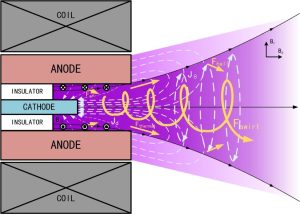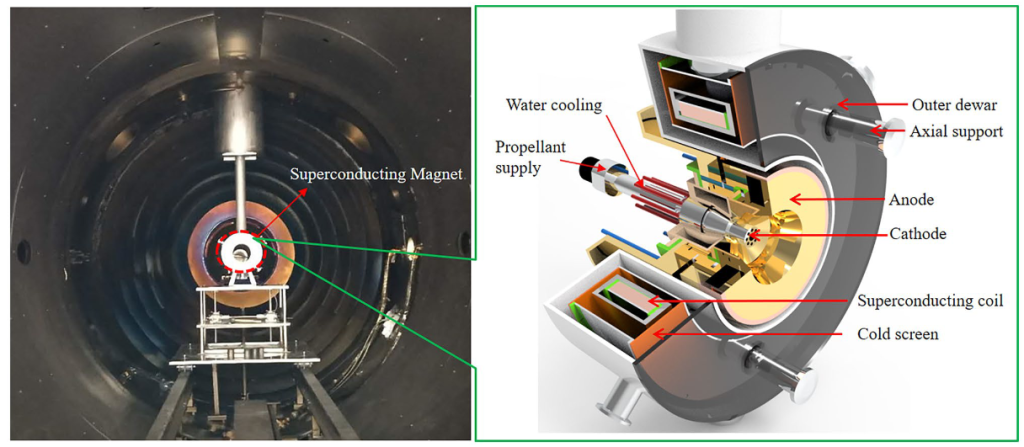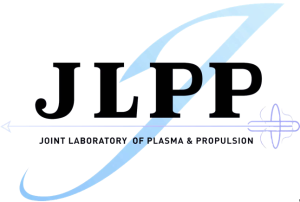Our research
MPDT
With the development of space technology, applied field magnetoplasmadynamic thrusters (AF-MPDTs) become more and more attractive for manned space flight, deep space exploration, and so on. The research on MPDT was first started in the 1960s and has made big progress in the United States of America, Germany, Japan, Italy, Russia, and China. An AF-MPDT is one of the potential thrusters at hundred-kilowatt power levels, which have wide thrust levels (0.1-100 N), high specific impulse (2000 – 5000 s), and high thrust efficiency (up to 75%). The AF-MPDTs can generate relatively high-energy plasma by arc discharge, and additional coils are utilized to convert the electric energy into the axial kinetic energy of propellant by the Lorentz force.

The acceleration mechanisms of AF-MPDT
Because of the significant physical coupling effect in AF-MPDT, the understanding of the main acceleration mechanisms in AF-MPDT are still limited. According to the most popular views, the acceleration mechanisms of AF-MPDTs are composed of the self-magnetic acceleration, the swirl acceleration, the hall acceleration, and the electrothermal acceleration, as shown in Figure 1.
- Self-magnetic acceleration: The discharge currents induce azimuthal magnetic fields , which interact with the radial currents and generate the axial Lorentz force.
- Swirl acceleration: The interaction between applied axial magnetic fields and radial currents produces the azimuthal Lorentz force, which can rotate the plasma. The plasma rotational kinetic energy can be converted into the axial kinetic energy in the magnetic nozzle.
- Hall acceleration: The interaction between applied axial magnetic fields and discharge currents can also induce the azimuthal currents . The induced currents interact with the applied radial magnetic fields and generate the axial Lorentz force.
- Electrothermal acceleration: The electric energy of the power supply can be also transformed into the plasma internal energy by Joule heating, viscous heating, and so on. The internal energy then can be converted into the axial kinetic energy by the magnetic nozzle.
With the increasing demand for high-power electric propulsion, many countries have increased their investment in AF-MPDT, especially in the United States of America, Germany, Japan, Italy, Russia, and China.
- The United States of America: The AF-MPDT is primarily conducted at Princeton University, which is called the lithium Lorentz Force Accelerator (LiLFA). The best performance of this type of thruster is 800 mN of thrust, 4081s of specific impulse, and 53% of efficiency at 30kW.
- Germany: The argon-fed AF-MPDT (SX3) in Germany is primarily conducted at the Institute for Space Systems of the University of Stuttgart, which has a thrust of 1.4N, a specific impulse of 4700s, and an efficiency of 62% at 51kW.
- China: The AF-MPDT in China is jointly developed by Beihang University, Beijing Institute of Control Engineering, and the Chinese Academy of Sciences. This argon-fed AF-MPDT uses superconducting magnet technology and has a thrust of 4.0N, a specific impulse of 5700s, and a thrust efficiency of 76%.

Beihang superconducting AF-MPDT
Apart from the jointly developed 150kW AF-MPDT, there is a new design of argon-fed AF-MPDT (TC-AF-MPDT) in our lab. Compared with the traditional AF-MPDT, this type of thruster decreases the discharge chamber and enhanced the role of the magnetic nozzle. The best performance achieved by TC-AF-MPDT is obtained at a discharge current of 250A, power of 24.9kW, and a magnetic field of 0.15T. The maximum thrust is 750mN, the maximum impulse is 3648 s and the best thrust efficiency is 54%. Compared with the traditional AF-MPDT, the thrust and discharge voltage can be increased by 17.7% and 23.5% at a discharge current of 250 A and a magnetic field of 0.1 T.

The pictures of thruster ignition
Featured articles:
[1] Wang, B., Yang, W., Tang, H., Li, Z., Kitaeva, A., Chen, Z., Cao, J., Herdrich, G., Zhang, K., 2018. Target thrust measurement for applied-field magnetoplasmadynamic thruster. Meas. Sci. Technol. 29, 075302. https://doi.org/10.1088/1361-6501/aac079
[2] Wang, B., Tang, H., Wang, Y., Lu, C., Zhou, C., Dong, Y., Wang, G., Cong, Y., Luu, D., Cao, J., 2018. A 100 KW Class Applied-field Magnetoplasmadynamic Thruster. Jove-Journal of Visualized Experiments. https://doi.org/10.3791/58510
[3] Kitaeva, A., Tang, H., Wang, B., Andreussi, T., 2019. Theoretical and experimental investigation of low-power AF-MPDT performance in the high mass flow rate low discharge current regime. Vacuum 159, 324–334. https://doi.org/10.1016/j.vacuum.2018.10.046
[4] Wu, P., Wang, Y., Li, Y., Wang, B., Zhang, K., Tang, H., Cao, J., 2020. Cathode erosion site distributions in an applied-field magnetoplasmadynamic thruster. Plasma Sci. Technol. 22, 094008. https://doi.org/10.1088/2058-6272/ab9172
[5] Wu, P., Wang, Y., Li, Y., Chen, Z., Zhu, T., Tang, H., 2021. Anode power deposition in applied field magnetoplasmadynamic thruster. Journal of Applied Physics 130, 243305. https://doi.org/10.1063/5.0065576
(Lastly Updated in September, 2022)
